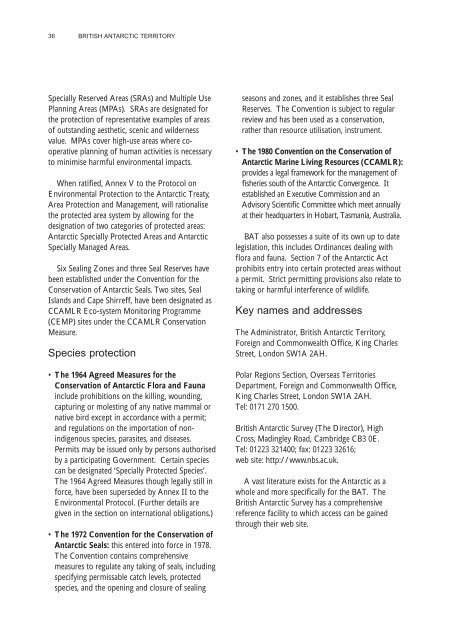Biodiversity: the UK Overseas Territories - WIDECAST
Biodiversity: the UK Overseas Territories - WIDECAST
Biodiversity: the UK Overseas Territories - WIDECAST
You also want an ePaper? Increase the reach of your titles
YUMPU automatically turns print PDFs into web optimized ePapers that Google loves.
36 BRITISH ANTARCTIC TERRITORY<br />
Specially Reserved Areas (SRAs) and Multiple Use<br />
Planning Areas (MPAs). SRAs are designated for<br />
<strong>the</strong> protection of representative examples of areas<br />
of outstanding aes<strong>the</strong>tic, scenic and wilderness<br />
value. MPAs cover high-use areas where cooperative<br />
planning of human activities is necessary<br />
to minimise harmful environmental impacts.<br />
When ratified, Annex V to <strong>the</strong> Protocol on<br />
Environmental Protection to <strong>the</strong> Antarctic Treaty,<br />
Area Protection and Management, will rationalise<br />
<strong>the</strong> protected area system by allowing for <strong>the</strong><br />
designation of two categories of protected areas:<br />
Antarctic Specially Protected Areas and Antarctic<br />
Specially Managed Areas.<br />
Six Sealing Zones and three Seal Reserves have<br />
been established under <strong>the</strong> Convention for <strong>the</strong><br />
Conservation of Antarctic Seals. Two sites, Seal<br />
Islands and Cape Shirreff, have been designated as<br />
CCAMLR Eco-system Monitoring Programme<br />
(CEMP) sites under <strong>the</strong> CCAMLR Conservation<br />
Measure.<br />
Species protection<br />
• The 1964 Agreed Measures for <strong>the</strong><br />
Conservation of Antarctic Flora and Fauna<br />
include prohibitions on <strong>the</strong> killing, wounding,<br />
capturing or molesting of any native mammal or<br />
native bird except in accordance with a permit;<br />
and regulations on <strong>the</strong> importation of nonindigenous<br />
species, parasites, and diseases.<br />
Permits may be issued only by persons authorised<br />
by a participating Government. Certain species<br />
can be designated ‘Specially Protected Species’.<br />
The 1964 Agreed Measures though legally still in<br />
force, have been superseded by Annex II to <strong>the</strong><br />
Environmental Protocol. (Fur<strong>the</strong>r details are<br />
given in <strong>the</strong> section on international obligations.)<br />
• The 1972 Convention for <strong>the</strong> Conservation of<br />
Antarctic Seals: this entered into force in 1978.<br />
The Convention contains comprehensive<br />
measures to regulate any taking of seals, including<br />
specifying permissable catch levels, protected<br />
species, and <strong>the</strong> opening and closure of sealing<br />
seasons and zones, and it establishes three Seal<br />
Reserves. The Convention is subject to regular<br />
review and has been used as a conservation,<br />
ra<strong>the</strong>r than resource utilisation, instrument.<br />
• The 1980 Convention on <strong>the</strong> Conservation of<br />
Antarctic Marine Living Resources (CCAMLR):<br />
provides a legal framework for <strong>the</strong> management of<br />
fisheries south of <strong>the</strong> Antarctic Convergence. It<br />
established an Executive Commission and an<br />
Advisory Scientific Committee which meet annually<br />
at <strong>the</strong>ir headquarters in Hobart, Tasmania, Australia.<br />
BAT also possesses a suite of its own up to date<br />
legislation, this includes Ordinances dealing with<br />
flora and fauna. Section 7 of <strong>the</strong> Antarctic Act<br />
prohibits entry into certain protected areas without<br />
a permit. Strict permitting provisions also relate to<br />
taking or harmful interference of wildlife.<br />
Key names and addresses<br />
The Administrator, British Antarctic Territory,<br />
Foreign and Commonwealth Office, King Charles<br />
Street, London SW1A 2AH.<br />
Polar Regions Section, <strong>Overseas</strong> <strong>Territories</strong><br />
Department, Foreign and Commonwealth Office,<br />
King Charles Street, London SW1A 2AH.<br />
Tel: 0171 270 1500.<br />
British Antarctic Survey (The Director), High<br />
Cross, Madingley Road, Cambridge CB3 0E.<br />
Tel: 01223 321400; fax: 01223 32616;<br />
web site: http://www.nbs.ac.uk.<br />
A vast literature exists for <strong>the</strong> Antarctic as a<br />
whole and more specifically for <strong>the</strong> BAT. The<br />
British Antarctic Survey has a comprehensive<br />
reference facility to which access can be gained<br />
through <strong>the</strong>ir web site.
















